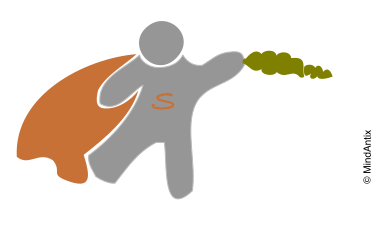How do creative ideas come about? What cognitive processes underlie creativity? These questions have been a source of fascination and research among psychologists for a long time. One thinking pattern that comes up most often as an explanation is associative thinking.
The first influential theory that tied associative thinking to creativity was put forth by Mednick. He defined the creative thinking process as the “forming of associative elements into new combinations which either meet specified requirements or are in some way useful.” He proposed that how associations are organized in the brain determines how creative people are. Less creative people show steep associative hierarchies (only a few associations will show high associative response strength) while highly creative people have flat associative hierarchies.
While some of Mednick’s predictions didn’t turn out to be true, he was right about the associative nature of creativity. Recent research is starting to reveal more about associative thinking and how it ties to both creativity and intelligence.
Benedek and colleagues investigated associative processes and how they impact creativity and intelligence. The four kinds of associative processes they studied were:
- Associative Fluency – The ability to generate as many associations as possible to a given trigger. For example, apple: “red”, “juicy”, “round”.
- Associative Flexibility – The ability to build a long and diversified associative chain where each item is associated only to the preceding one. For example, apple: “red”, “blood”, “bandaid”.
- Dissociative Ability – The ability to generate a list of unrelated concepts. For example, apple: “pencil”, “shirt”, “screwdriver”.
- Associative Combination – The ability to find an associations related to completely unrelated stimuli. For example apple – beanbag: “round”, “squishy”.
Their analysis showed that “associative combination and dissociative ability are significant predictors of creativity, whereas both have no significant relationship to intelligence. In contrast, intelligence is predicted by associative flexibility, which in turn has no significant relationship to creativity.”
Our latest brainteaser category, “Superheros to the Rescue”, suggested by a MindAntix user, builds on the associative combination thinking. In this kind of brainteaser, there are two completely unrelated concepts – a crisis (e.g. the family kitten is stuck on a tree) and a Superhero with a rather strange superpower (e.g. the “Whipped Cream Man” who can shoot foamy, gooey whipped cream) who needs to save the day. The key to solving the brainteaser is to construct a story that uses the superpower in a meaningful way to solve the problem.
We love this idea from our user because it beautifully captures the essence of the combinatorial form of associative thinking in a fun way. Well done! In fact, constructing a brainteaser in this category builds both the dissociative ability (the crisis and the super power are completely unrelated) and the associative combination (the solution has to tie the two concepts in a meaningful way).
So it’s your turn now. Can you think of a way the Whipped Cream Man could help save the kitten? Have fun using your imagination and creativity to solve this!

